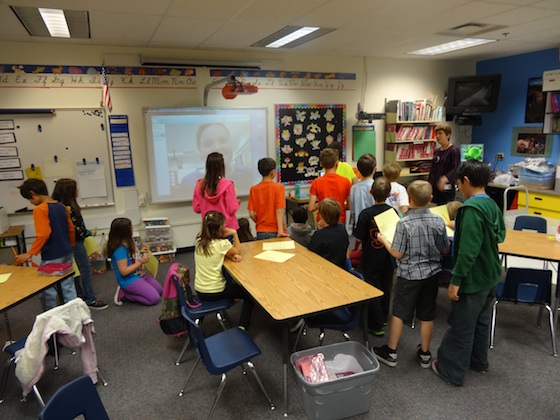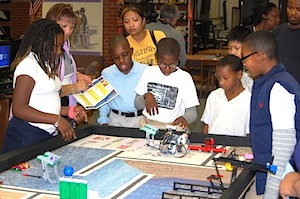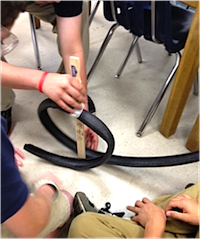by Brian Crosby
When students are connected (and this is especially valuable for second language learners), everything you do has the potential for being language intense. Opportunities arise that motivate your students to interact at a high level and require them to be articulate to be understood.
This becomes apparent when they first connect through video-conferencing or other social media that requires fluent oral language. They stumble and “Um” and “Ah” – followed by long, very pregnant pauses while they grasp tenuously for the words. Record those first experiences and play them back for students in a supportive atmosphere, and contrast them to examples exhibiting fluency.
Next, have the students interpret the reasons they struggle to communicate well and what is lacking. List them and work with students to develop ideas about how to improve, so next time they have the words and the meaning to express themselves.

Leveraging STEM & Maker learning
Here is where constructivist experiences leverage the language learning and vice-versa. When students have a great constructivist or other experience, they also develop the mental schema about that experience. Being connected gives them a real reason to share with language – language that they are more likely to spend more time thinking through and practicing so they can share fluently. The more of those real-world, language intense, deep thinking experiences we can provide students the better.
STEM and Maker learning provide first-person experiences around which your students can sharpen speaking, writing and reading skills. (Often art and design sneak into projects too, gasp!) If students are also reading and writing about their learning and experiences, through blogging for example, and they are scaffolded in doing so, much of the language they will require to present orally is built and practiced through the writing process.
 Since being published globally in written or audio/visual media is performance oriented, you’ve provided a reason for them to be excited and motivated about participating and sharing what they did and learned!
Since being published globally in written or audio/visual media is performance oriented, you’ve provided a reason for them to be excited and motivated about participating and sharing what they did and learned!
And what about those times when the world is not your stage? When students are connected, even simple communication like a text message can be the opening to information, expertise, advice or encouragement that can lead to deep, complex or important learning. It’s not that being connected is more important than what you want to learn about or learn to do. It is that connectedness can and does lead to learning or resources to learn from and with.
Connections matter to learners
One of the huge advantages children of non-poverty families have is their connections – the kind of connections students of poverty just don’t typically have. Teachers can help students make these connections.
Connections to experts, for example:
“I don’t know much about how carpenters use fractions in their work (or which type of saw or glue or whatever is best for building that). But Mr. Johnson is a carpenter, I’ll give him a call (or text or Tweet or email or video-conference) and let’s see what he can tell you.” …
“I don’t know anything about photography but Mrs. Perez is a professional photographer. Let’s text her and see if she can help you or point you in the right direction. She might know how to take time lapse photographs so you can see what isn’t working on your roller coaster.”
 Even having ubiquitous family access and proficiency in using the internet is a game-changer. I remember as a child, conversations with some of my parents’ friends and acquaintances often led me to want to know more about something or helped me see why or how I might want to try a different strategy to do something. How do we create that experience for our students who haven’t experienced these kinds of conversations?
Even having ubiquitous family access and proficiency in using the internet is a game-changer. I remember as a child, conversations with some of my parents’ friends and acquaintances often led me to want to know more about something or helped me see why or how I might want to try a different strategy to do something. How do we create that experience for our students who haven’t experienced these kinds of conversations?
Learning in connected classrooms (supported by connected teachers) helps provide or expand connections that some families may not have or know how to utilize in helping their children learn. Our role as teachers is to facilitate as students build their own personal learning networks, showing them how to utilize those networks in meaningful, courteous ways.
And all the while, they are acquiring the entire panoply of literacy skills we know are important today: reading, writing, speaking, and communicating effectively in the virtual world.
Brian Crosby
Latest posts by Brian Crosby (see all)
- Sharing Real-World Projects Sharpens the Literacy Skills of Connected Students - October 24, 2013
- Going Deep: STEM in the Connected Classroom - March 15, 2013
- My Voice for Change: Muted, But Not Silenced - July 6, 2012


Trackbacks/Pingbacks